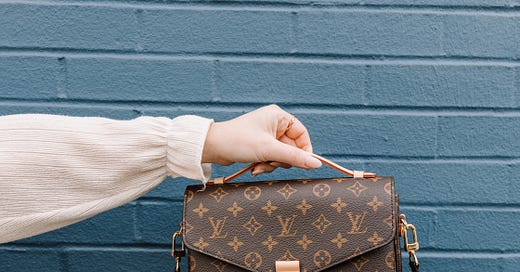LVMH, How it Dominates the Luxury World
Visible results from the network effect
The success of LVMH is impressive. Operating on a decentralised model with highly independent “Maisons”, the group's strength lies in its networks, its talents and its exceptional financial resources at the service of its brands.
Like Midas, Bernard Arnault seems to turn everything he touches into gold. Its children are already in strategic positions. The last acquisitions proved to be really successfull.
In this article, we analyse the company's business and look at the keys to its success. We will also look at its valuation and the size of the market over the next few years. In this way, you will come away with a complete understanding of the company and the reasons for its success.
Business Overview
As we said, the luxury behemoth has a decentralised model. It is divided into 6 major divisions, each with its own “Maisons”:
Fashion and Leather Goods. 48.9% of the revenues. This is the biggest division of the company with huge brands like Louis Vuitton or Christian Dior. The brands are Louis Vuitton, Fendi, Marc Jacobs, Kenzo, Celine, Emilio Pucci, Rimowa, Loro Piana, Givenchy, Jean Patou, Christian Dior, Moynat, Berlutti and Loewe.
Selective Retailing. 20.7% of the revenues. Sephora is the main brand inside selective retailing and is really dynamic. The brands are Sephora, La Grande Epicerie, Starboard, DFS and 24S.
Watches and Jewelry. 12.6% of the revenues. This division has grown a lot since the buy of Tiffant & Co. The brands are Tiffany, Tag Heuer, Chaumet, Hublot, Bulgari, Zenith, Fred and Repossi.
Perfumes and Cosmetics. 9.6% of the revenues. In this division, you will find specific cosmetics “Maison” like Guerlain but also cosmetics part of fashion brands like “Parfums Christian Dior”. The brands are Parfums Christian Dior, Benefit, Maison Francis Kurkdjian, Fresh, Givenchy, Guerlain, Acqua Di Parma, Cha Ling, Make Up Forever, Stella, Kenzo, Fenty, Loewe, KVD.
Wines and Spirits. 7.8% of the revenues. Year 2022 was incredible for all the different brands, including Dom Perignon or Veuve Clicquot. 2023 is more complicated but this may create opportunities. Among the brands, we can find Veuve Clicquot, Krug, Cheval Blanc, Ruinart, Chandon, Henessy, Dom Perignon, Belvedere, Glenmorangie, Moët & Chandon, Chateau d’Yquem.
Other. 0.4% of the revenues. Here you will find hotels, media groups like Le Parisien, Belmond, Les Echos or Radio Classique
These 6 divisions allow to smooth some economic cycles. For instance, 2023 has been a tough year for Wines & Spirits but it has been compensated by selective retailing.
Geographically, Asia is the most important region and more specifically China. However, India is slowly becoming stronger, so this dependency tends to reduce.
Shareholder structure
It is important to understand the shareholder structure. Bernard Arnault doesn’t own LVMH directly.
LVMH’s 2 main shareholders are Christian Dior (a Holding) and Arnault Family. Together, they own 48% of LVMH. Christian Dior is owned by Arnault Family with 97.5% of the shares.
So don’t confuse Christian Dior the brand, inside LVMH, and Christian Dior the holding, just a financial structure, mostly owned by Arnault Family.
The power of the network effect
LVMH’s main strength is probably its acquisition capability. For the past years, the number of acquisitions is impressive and the sizes have increased (non-exhaustive list):
1993: Kenzo, Berlutti
1994: Guerlain
1995: Fred
1996: Loewe, Céline
1998: Sephora, DFS, Marc Jacobs
1999: Tag Heuer, Krug, Chaumet, Benefit
2000: Rossimoda, Pucci, Starboard
2001: Fendi, Acqua di Parma
2002: Belvedere Vodka
2004: Glenmorangie, Ardberg
2008: Hublot, Van Lent
2009: Moynat
2011: Bulgari
2013: Loro Piana
2015: Repossi
2016: Rimowa
2018: Patou
2019: Belmond, Fenty Beauty
2020: Tiffany
2021: Off-White
2022: Pedemonte Group
The success of these acquisitions lies in the fact that once they are part of the Group, the brands can benefit from its network. This is where the most powerful moat comes into play: the network effect. Brands also benefit from the company's financial structure, talent and strategic and marketing strength.
The example of Tiffany is very interesting on that matter. Since the acquisition, LVMH has made Tiffany change its strategy: new audience, bold and dynamic communication, new products and some very creative experiments. Tiffany’s performance increased significantly. In the high jewelry segment the sales even doubled, making the high acquisition price almost irrelevant.
They are almost the only company to be able to pay for expensive brand and still gain a lot from it.
Corporate Social Responsibilities
LVMH is putting a great deal of effort into CSR. To this end, it has developed 3 action plans which are currently being implemented:
2025 CSR roadmap. 4 streams constitute this action plan: individuality & non-discrimination, health, safety & well-being, excellence through savoir-faire and engagement.
Life 360. Again 4 streams for this action plan: creative circularity, biodiversity, climate and traceability & transparency.
Art & Culture. Helping culture development through its Fondation, prize for young designers and art & culture support.
Market by 2030
Keep reading with a 7-day free trial
Subscribe to Quality Stocks to keep reading this post and get 7 days of free access to the full post archives.





